Lush growth, primarily sea anemones, on an active outfall diffuser in 2020
Massachusetts Water Resources Authority
PRESS RELEASE
Posted:
December 13, 2021
Contact:
Ria Convery
(617) 788-11105, Ria.Convery@mwra.com
MWRA Releases Annual Deer Island Outfall Monitoring Report
|
MWRA's Outfall Monitoring Overview is an annual report that summarizes the results of MWRA's monitoring of the environmental effects of the effluent discharges from the Deer Island Treatment Plant. MWRA monitors the effluent, as well as the water, sediment and the health of fish and shellfish in Massachusetts and Cape Cod Bays. 2020 marked the 29th consecutive year of monitoring and 20 years since the effluent discharge moved to Massachusetts Bay when the outfall came on-line. The COVID-19 pandemic impacted environmental monitoring in 2020, as safe alternative sampling protocols were developed and then implemented between MWRA, it's regulators and sampling partners. Gaps in data, due to COVID-19, precluded calculation of three Contingency Plan thresholds, which was acceptable to regulators in the context of disruptions due to the pandemic. Regulators and members of the advisory panel expressed their appreciation for how proactive and resourceful MWRA and its consultants were, to keep the impacts of the pandemic so limited. MWRA is pleased to report that test results for 2020 show that the Deer Island Treatment Plant continues to operate as designed, and that discharges through the MWRA Outfall had no unexpected effects on the waters or ecosystems of Massachusetts and Cape Cod Bays. Water quality remains good and both the plankton and seafloor animal communities remains healthy and diverse. Summary of Effluent Quality Monitoring
MWRA is also playing an active role working with other agencies and institutions in researching regional CECs (contaminants of emerging concerns, e.g., per- and polyfluoroalkyl substances, microplastics and pharmaceutical and personal care products). At no cost to ratepayers, MWRA participated in the planning of a multi-agency pilot study investigating PFAS and PPCPs in Deer Island effluent and in Massachusetts Bay. Additionally, MWRA is supporting a research project by Woods Hole Oceanographic, funded by Sea Grant, to investigate and better understand the distribution of microplastics throughout Massachusetts Bay. Solids discharge levels have been reduced by over 90% since 1990 The amount of solids, or organic particles, in MWRA effluent remained low in 2020. Overall, solids discharge levels have been reduced by over 90% since 1990. Solids are a concern as they could make the receiving water cloudy and contribute to reduced dissolved oxygen concentrations in the water and bottom sediments. Also, most metals and other priority pollutants attach to solids, so removing solids also removes metals and other pollutants from the effluent discharge into Massachusetts Bay. Levels of solids and metals are even lower than predictions made before MWRA improved and upgraded sewage treatment. Actual pollutant loads in MWRA effluent compared with early predictions Metals in effluent remained at low levels in 2020. Metals can be toxic to marine life, and their discharge has been greatly reduced by improved secondary treatment and MWRA’s enforcement of industrial pre-treatment programs. Marine life thrives on an outfall diffuser, July 2020 More Information For more information about water quality in Boston Harbor, its tributary rivers and Massachusetts Bay, visit our Harbor and Bay Water Quality Report page. 2020 Outfall Monitoring Overview summary |
|
### |
Follow us |



